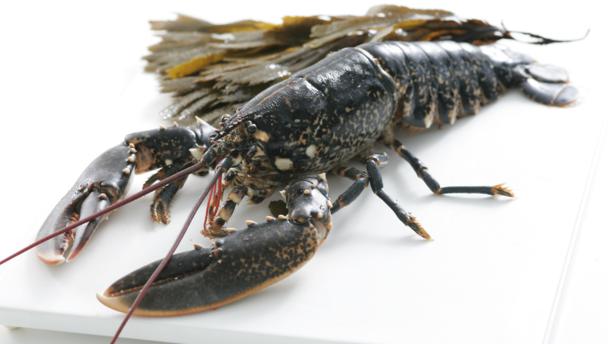

Although there many lobster varieties around the world, the two main ones are the American (or Maine) lobster, which is considered the biggest and best, and the European lobster, which tends to be smaller - they can be used interchangeably in recipes. Lobster is often sold cooked, but will be at its freshest and tastiest if you buy it live and cook it yourself. Live lobsters are usually a greeny-blue colour and turn reddish-orange when cooked. Males have denser, meatier flesh, but females have a more subtle flavour and an orange 'coral' roe that is often used to colour sauces. Since lobsters are very expensive, the best way to enjoy the sweet flesh is to cook them simply, either halved and grilled or baked, or boiled or steamed, and served with a butter sauce, lemon juice or mayonnaise. If you're feeling adventurous, try using lobster in a mousse or risotto, or cook the classic Lobster thermidor – grilled lobster halves served with a mustard cheese sauce.
 'Dragon prawn' noodles
'Dragon prawn' noodles
 Lobster with spaghetti
Lobster with spaghetti
Lobsters are always considered a luxury food, and it’s unlikely that you’ll eat them often. However the Marine Conservation Society advises avoiding American lobsters from Southern New England as they are a vulnerable source.
Lobsters are available both live, cooked and frozen if you know where to buy them (cooked are often the easiest to manage and the flesh can be removed from the shell with only a limited amount of expertise). Lobsters can grow to be 4.5kg/10lb, but are best eaten at about 500g-1.4kg/1lb-3lb. In general, the smaller the lobster, the more tender it will be. Coldwater lobsters from more northern seas are considered to be the finest quality.
To kill a live lobster, either place it in the freezer for a few minutes to dull its senses then steam, or pierce it just behind the head with a sharp, heavy knife or skewer. Lobsters are almost entirely edible apart from the transparent bag-like stomach and the dark intestines, which should be removed with a sharp knife point. Keep the creamy green-grey liver (the 'tomalley'), which has an excellent flavour. The shell is too hard to eat but can be reserved and used to make fish stock, or as the base for a soup, bisque or lobster sauce.
Article by CJ Jackson
Type the ingredients you want to use, then click Go. For better results you can use quotation marks around phrases (e.g. "chicken breast"). Alternatively you can search by chef, programme, cuisine, diet, or dish (e.g. Lasagne).